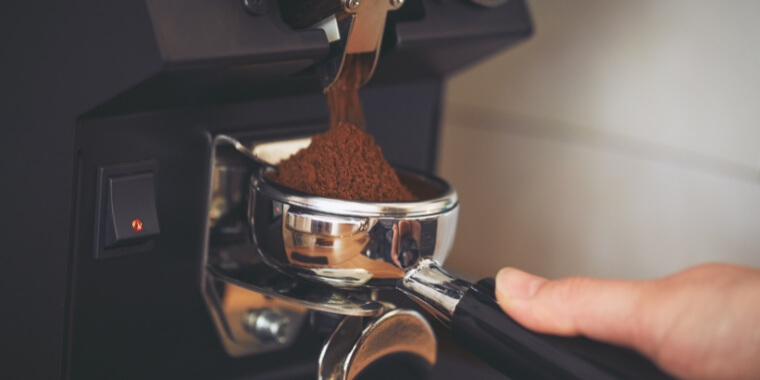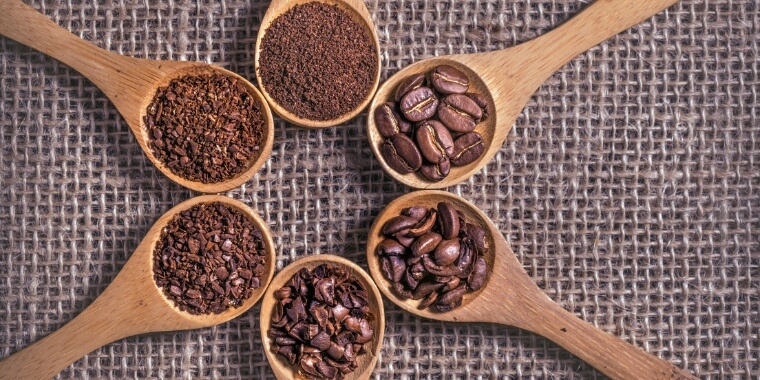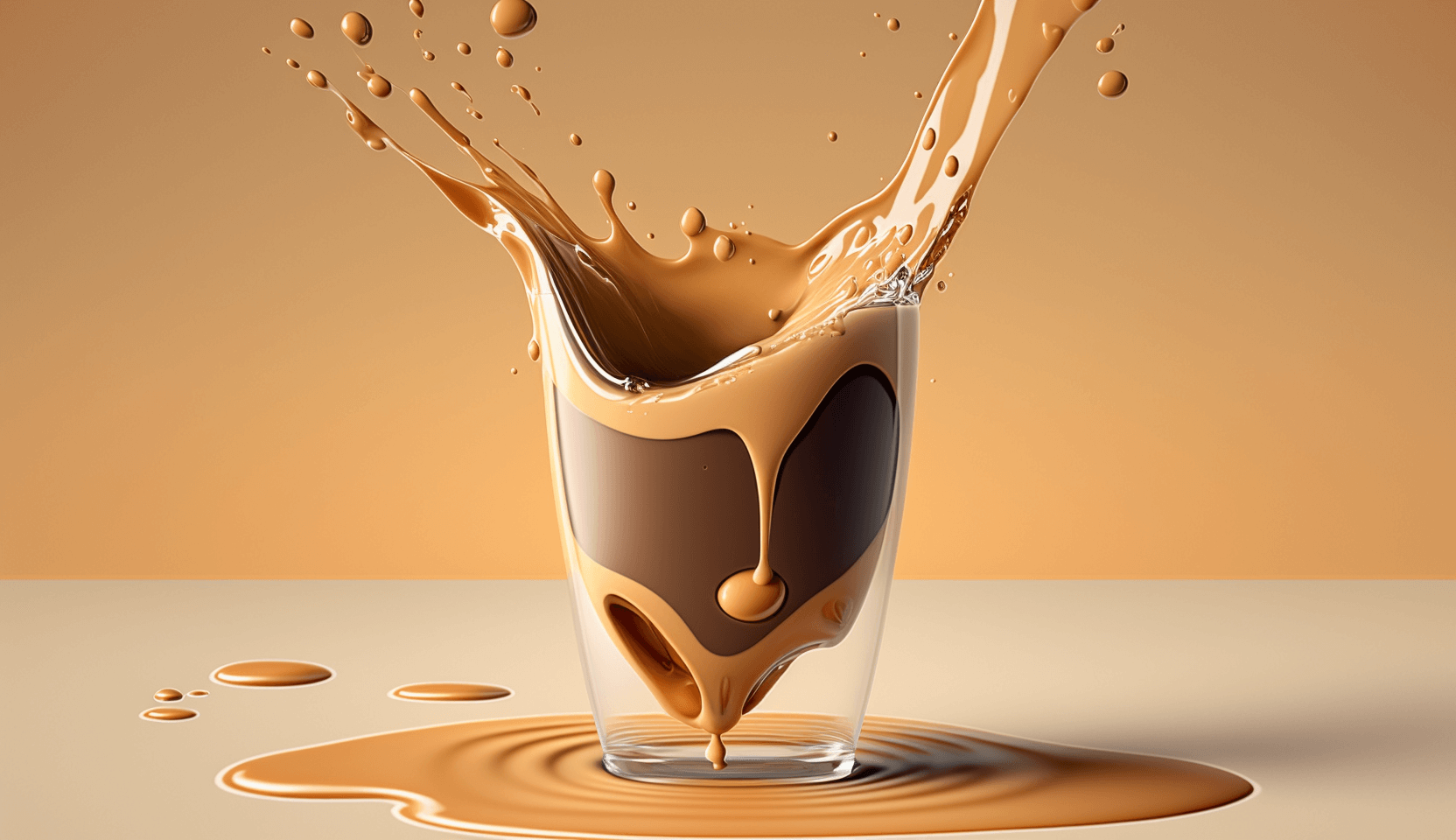Paying attention to the grind size may seem like a small detail, but it has a massive impact on the overall taste and quality of your espresso.
Why?
Because the grind size determines how easily water can flow through the coffee grounds, affecting the extraction process. Too fine, and you risk over-extraction, which can lead to a bitter, unpleasant taste.
So, let’s dive right into the world of grinding, and how it can make or break the flavor and extraction of your favorite shot.
Table of Contents

What’s The Best Grind Size for Espresso?
One of the most critical factors in brewing a great shot is getting the grind size just right.
So, let’s chat about how fine should coffee be ground for espresso and how it can make all the difference in the world.
First off, you’re going to want a grind that’s slightly finer than table salt. That’s the magical consistency that allows the water to flow through the grounds at the perfect speed, extracting flavors and oils that make espresso so unique.
Of course, the exact grind size may vary slightly depending on your coffee beans and espresso machine, but starting with this consistency will put you on the right track.
The grind size needs to be fine enough to create resistance, ensuring that the water is forced through the grounds at the right pressure.
It’s essential to remember that fine grinds and espresso makers go hand in hand.
Espresso machines are specifically designed to work with fine grinds, as they rely on pressure and precise water flow to create that perfect shot. So, be sure to keep this in mind when selecting your coffee grinder and setting it up for espresso brewing.
In my experience, finding the optimal grind size for espresso is all about experimentation, patience, and a little bit of trial and error. Don’t be afraid to adjust your grind size and tweak your technique until you find what works best for your specific setup.
Coffee Grind Size Chart: Your Guide to the Perfect Brew

To help you on your journey to brewing the perfect cup, I’ve created a comprehensive coffee grind size chart.
This easy-to-understand guide will help you determine the ideal grind size for various brewing methods, ensuring you enjoy the full potential of your favorite coffee beans.
Take a look at the table below, and let it be your roadmap to a delicious and satisfying espresso experience:
| Grind Size | Texture | Brewing Methods | Particle Size (in mm) |
|---|---|---|---|
| Extra Coarse | Similar to peppercorns or kosher salt | Cold brew, cowboy coffee | 1.3 – 1.6 |
| Coarse | Similar to sea salt or coarse sand | French press, percolator, cupping | 1.0 – 1.3 |
| Medium-Coarse | Comparable to rough sand | Chemex, Clever Dripper | 0.6 – 1.0 |
| Medium | Similar to regular sand | Drip coffee makers with flat-bottom filters, AeroPress (3-4 minute brew time) | 0.5 – 0.6 |
| Medium-Fine | Finer than sand, not as fine as espresso | Cone-shaped pour-over brewers (e.g. Hario V60, Kalita Wave), AeroPress (2-3 minute brew time) | 0.4 – 0.5 |
| Fine (Espresso) | Comparable to powdered sugar | Espresso machines, moka pot | 0.3 – 0.4 |
| Extra Fine (Turkish) | Very fine, almost | Turkish coffee | < 0.3 |
How to Grind Espresso Beans
First and foremost, invest in a burr grinder. They provide consistency in grind size, which is essential for perfecting your espresso shots. I can’t stress enough how important it is to have uniformly ground coffee for espresso brewing.
When it comes to grind settings, aim for fine or superfine coffee grounds. Remember, espresso requires a fine grind to create the right resistance for the water to pass through. If you’re new to grinding espresso beans, don’t be afraid to start with a few beans at a time to get used to the settings.
Adjusting Grind Size for Different Espresso Machines
Now, let’s talk about how to set the right grind size for your specific espresso machine. It’s essential to understand that different machines might require slightly different grind sizes to achieve the perfect extraction.
The impact of grind size on brew time and taste is significant. Too coarse, and your espresso might taste weak and under-extracted. Too fine, and you could end up with an over-extracted, bitter shot. Keep an eye on the brew time: ideally, it should take around 25 seconds to pull a double shot of espresso.
My advice? Experiment with your grind size and taste the results. Make small adjustments and pay attention to how it affects the taste and brew time. Over time, you’ll learn to dial in the perfect grind size for your espresso machine.
Blade Grinder vs Burr Grinder: Which Grinder To Choose?

Let’s dive into the debate between blade grinders and burr grinders to help you make the best choice for your daily brew.
Blade Grinders: Random Chopping and Inconsistent Flavor
Blade grinders operate similarly to food mixers, randomly chopping up coffee beans into uneven pieces.
This results in an inconsistent grind, with some grounds being fine while others are coarser.
The uneven grounds can lead to bitter over-extraction and an inconsistent flavor in your cup of coffee.
Another downside to blade grinders is that they can heat up during operation, potentially burning the beans before you even begin brewing.
This, in turn, can further impact the flavor of your coffee.
Burr Grinders: Precision Crushing for Consistent Results
In contrast, burr grinders crush coffee beans down to a specific size, ensuring a more consistent grind.
The adjustability of burr grinders means you can easily tweak the grind size for finer or coarser grinds, depending on your brewing method.
Within the realm of burr grinders, conical burr grinders are considered the gold standard. They offer better control over grind size and are less likely to clog compared to flat burrs.
When it comes to choosing between blade and burr grinders, the latter is a clear winner for me.
Burr grinders, particularly conical burr grinders, provide more consistent grounds, better flavor, and more control over your coffee grind.
While blade grinders may be more affordable, the investment in a quality burr grinder will significantly improve your coffee experience in the long run.
Troubleshooting Espresso Grind Issues

If you’ve ever had issues with your espresso grind, you’re not alone. I’ve faced my fair share of espresso grind troubles.
Let me guide you through some common issues and how to fix them, so you can enjoy your perfect espresso in no time:
Espresso Taste is Off
One of the first signs of grind issues is if your espresso is too weak or too strong, sour, bitter, or lacks flavor. These issues often stem from the grind being too fine or too coarse, affecting the extraction process.
No Crema on The Top
Another sign of grind issues is if your espresso has no crema. Crema is that lovely golden layer on top of a well-extracted espresso shot, and it’s a good indicator of whether your grind is on point.
Keep Proper Coffee To Water Ratio
So, how can we adjust the grind size for better extraction and taste?
First, remember the golden rule: the ideal espresso ratio is 1:2, meaning for every 10 grams of coffee, you should end up with about 20 ml of liquid coffee. Experiment with small adjustments to your grind size while keeping this ratio in mind.
If your espresso is too weak, bitter, or lacks flavor, try a finer grind setting. This will slow down the extraction, allowing more time for the water to pick up the coffee’s flavors.
On the other hand, if your espresso is sour or too strong, go for a coarser grind. This speeds up the extraction, reducing the chance of over-extraction.
Take Care Of Your Grinder
It’s essential to pay attention to your grinder as well. Ensure it’s clean and free of any foreign materials that might cause jamming or inconsistent grinds. A well-maintained grinder is key to achieving the perfect espresso grind.
Some Other Questions You May Have
What is Espresso Grind?
Espresso grind refers to coffee beans ground to a very fine texture, similar to powdered sugar.
This fine grind size is crucial for brewing the perfect espresso, as it allows water to pass through the coffee grounds at high pressure, extracting maximum flavor.
If the grind is too coarse, you’ll end up with watery coffee, while an overly fine grind can cause issues with water flow.
What Should Espresso Grind Look Like?
The ideal espresso grind should be fine, with ground particles around 1/32 of an inch or 0.8 mm.
The perfect grind size can vary depending on the coffee beans and the espresso machine you’re using, so it’s important to experiment a bit.
Start with a medium-fine setting and make adjustments until you find the sweet spot.
What Kind Of Grind for Stovetop Espresso?
For stovetop espresso makers, you should use a fine coffee grind.
The ideal grind size will be similar in size and feel to that of sugar, but slightly coarser than a grind used for a regular espresso maker.
The coffee grind for stovetop espresso should be fine enough to increase the pressure required to push the water through the filter and create a good crema. However, be cautious not to grind the coffee too fine, as it may block the coffee filter.
My Final Thoughts
As a coffee enthusiast, I can’t stress enough the importance of finding the perfect grind size for your espresso. It’s all about experimentation and consistency to achieve that heavenly taste we all crave.
Remember, practice makes perfect, so don’t be afraid to adjust your grind and brew until you find the sweet spot. Keep brewing, tasting, and learning, and soon enough, you’ll be a master at crafting the best espresso experience.
Do you have any tips I should add to the article? How fine do you grind espresso beans? Let me know in the comments!

